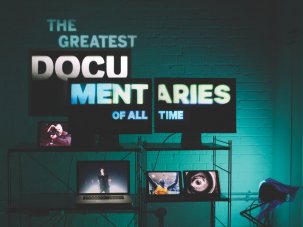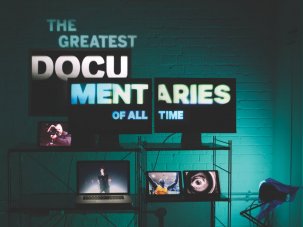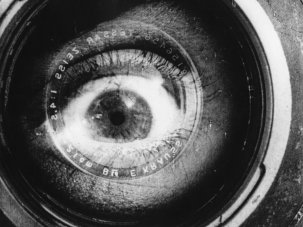
The new Sight & Sound documentary poll is the result of a “why didn’t we think of that before” moment. In the light of the amazing recent success and cultural impact of several nonfiction films, a group of curators, myself included, were chewing over what the BFI might do specifically for documentary films and television. It soon became obvious that we were not sure exactly what it was that we were trying to discuss.
Posted to subscribers and available digitally 1 August
→
→ Sign up / log in
On UK newsstands 5 August
I’m usually loath to do anything that takes lustre away from Sight & Sound’s ten-year poll of the Greatest Films of All Time but a new poll seemed to me the most obvious solution to getting a full view of the documentary canon. Approximately four months later I’m delighted with the quality of what more than 200 critics and curators – including many documentary specialists – and 100 filmmakers – the likes of John Akomfrah, Thom Andersen, Michael Apted, Clio Barnard, Sophie Fiennes, Amos Gitai, Paul Greengrass, José Luis Guerin, Isaac Julien, Asif Kapadia, Sergei Loznitsa, Kevin Macdonald, James Marsh, Joshua Oppenheimer, Anand Patwardhan, Pawel Pawlikowski, Nicolas Philibert, Walter Salles and James Toback – have come up with in terms of choices and commentary and I’m very proud of the team of advisors, BFI colleagues and S&S editors who have worked so hard to produce this poll edition.
What’s remarkable about the Top 50 documentaries list is that it feels so fresh. One in five of the films chosen were made since the millennium, and to have a silent film from 1929 at the top of the list is an absolute joy. That allusive essay films feature so strongly throughout demonstrates that nonfiction cinema is not a narrow discipline but a wide open country full of explorers. The current print edition of S&S contains only the highlights of our results; the real explorers among you will want to browse the full results and commentaries which goes live online on the 14th August.
-
Sight & Sound is now available in digital editions for Apple iOS, Android and Kindle Fire as well as computer desktops. Scroll this gallery to browse this issue’s sections.
-
RUSHES: German film poster designer Hans Hillmann, five key jewel thief movies, the TV version of Italian mafia saga Gomorrah plus Hannah McGill on bones and Mark Cousins on the non-Western documentary film canon
-
THE INDUSTRY: Hector and the Search for Happiness, the surprise box-office success of Richard Linklater’s Boyhood and the arthouse circuit outside the M25
-
FESTIVALS: Bologna’s Il Cinema Ritrovato festival, and the boldly unorthodox FIDMarseille festival
-
What are the greatest documentaries ever made? We polled 340 critics, programmers and filmmakers in the search for authoritative answers. Nick Bradshaw introduces the results
-
x`
-
The votes and thoughts of 100 filmmakers who took part in our poll, including Joshua Oppenheimer, Walter Salles, Penny Woolcock, James Toback, Asif Kapadia and Paul Greengrass
-
Charlotte Cook on how documentary filmmakers like Laura Poitras have stepped in to fill the gap as traditional media shies away from investigative reporting in the internet age
-
Robert Greene explores how the past 15 years have been a golden age for bold, adventurous documentary filmmaking
-
Jean-Pierre and Luc Dardenne’s Two Days, One Night follows a factory worker’s attempts to save her job. The directors talk to Isabel Stevens about the creative benefits of not giving a damn
-
A trio of green activists find themselves in deep water after plotting to blow up a dam in Kelly Reichardt’s environmental thriller Night Moves. Nick James introduces it, while Reichardt discusses radicalism and moral certainties with David Jenkins
-
In 1963, critic Raymond Durgnat was swimming against the tide in the pages of Motion magazine, helping transform film culture with his far-sighted advocacy of films such as Peeping Tom and Black Sunday. By Henry K. Miller
-
WIDE ANGLE: a defiant new crop of American independent filmmakers, artist filmmaker Ed Atkins, silent German director Gerhard Lamprecht, and the sonic terrain of the western
-
REVIEWS: Lilting, The Rover, Wakolda + 38 more new releases
-
HOME CINEMA: John Guillermin’s wonderful coming-of-age tale Rapture, previously unseen footage deepens David Lynch’s Twin Peaks – The Entire Mystery, Suzuki Seijun’s fresh blast of Japanese postmodernist cool Branded to Kill + 13 more new releases
-
BOOKS: the complex life of Hollywood star Ann Dvorak, two recent studies of Japanese cinema, a new study of costume and fashion in cinema and two beautiful booklets from Univocal Publishing
-
ENDINGS: Michael Brooke on The Thin Blue Line
Features
COVER FEATURE: Tall truths
What are the greatest documentaries ever made? Over the following 32 pages, we feature the votes of some of the 340 critics and filmmakers we polled in our search for authoritative answers. By Nick Bradshaw.
Plus James Bell, Jane Giles, Sophie Mayer, Pamela Hutchinson, Rachael Rakes, Nicolas Rapold, Philip French, Adam Nayman, Jonathan Rosenbaum and Brian Winston on our poll’s top ten documentaries, and a sample of 50 critics and 50 filmmakers on their greatest documentaries of all time.
Plus: The new journalism
As traditional media back away from investigative reporting in the internet age, documentary filmmakers like Laura Poitras are stepping in to fill the gap – but can they survive without institutional cover? By Charlotte Cook.
Plus: Flights of reality
The past 15 years have seen a sea change in documentary culture: filmmakers have grown more boldly adventurous as audiences have woken to the possibilities of the art . By Robert Greene.
The dam busters
A trio of green activists find themselves in deep water after plotting to blow up a dam in Kelly Reichardt’s environmental thriller Night Moves. The director discusses the meaning of radicalism and the dangers of ironcast moral certainties. Interview by David Jenkins, with an introduction by Nick James.
Poetry in motion
In 1963, as the auteurists were claiming ascendancy in the UK, critic Raymond Durgnat was swimming against the tide in the pages of Motion magazine, helping transform film culture his own way with his far-sighted advocacy of films such as Peeping Tom and Black Sunday. By Henry K. Miller.
Woman on the verge
Jean-Pierre and Luc Dardenne’s tense redundancy drama Two Days, One Night follows a factory worker’s attempts to persuade her fellow employees to save her job. The directors discuss the creative benefits of not giving a damn and why they can never resist the lure of long takes. By Isabel Stevens.
Regulars
Editorial
Eyes wide open
Rushes
In the frame: Enigma variations
From the 50s to the 70s, some of Europe’s greatest directors courted the German artist Hans Hillmann to make posters for their films. By Isabel Stevens.
Object lesson: Under the skin
A medium that’s all about the flesh has found some peculiar uses for what’s underneath – make no bones about it. By Hannah McGill.
The five key…: Jewel thief films
Common thieves steal money – uncommon thieves, more often than not, prefer something a little more glamorous. By Michael Brooke.
Preview: Tomorrow never dies
Gomorrah, Roberto Saviano’s book about the Neapolitan Camorra, already a hit on the big screen, is now Italy’s answer to Breaking Bad. By Pasquale Iannone.
Dispatches: Reloading the canon
Our idea of what counts as great nonfiction cinema is embarrassingly parochial. Maybe that is starting to change. By Mark Cousins.
The industry
Development tale: Hector and the Search for Happiness
How a Berlin-based producer, a Swedish writer and a British director took a globe-trotting French bestseller to London. By Charles Gant.
The numbers: Boyhood
Brewster: Playing to the audience
Making films is one thing – getting the films to audiences outside London and the arthouse circuit is another. By Ben Roberts.
Festivals
Time regained: Il Cinema Ritrovato
Bologna’s annual festival of the cinema of the past was a feast of gorgeous restorations and the paradoxically novel. By James Bell.
You, the jury: FID Marseille
FIDMarseille’s determinedly unorthodox approach to programming, and jury selection, helps it to punch above its weight. By Neil Young.
Wide angle
Preview: Difficult people
A new crop of truly independent young American cinema bristles with a defiance and hostility largely absent from the ‘indie’ scene. By Jason Anderson.
Soundings: Elemental space
Skeletal strings, mournful cellos and weighty silence – plus ambient noise – help stake out the terrain of westerns about characters adrift. By Frances Morgan.
Primal screen: The world of silent cinema
Before Emil and the Detectives, Gerhard Lamprecht’s ‘moral films’ unflinchingly showed Weimar-era degradation. By Bryony Dixon.
Artists’ moving image: Cold new world
Ed Atkins’s increasingly fêted videos highlight the uncanniness of CGI creations while using digital technology against itself. By Melissa Gronlund.
Reviews
Films of the month
Lilting
The Rover
Wakolda
plus reviews of
All This Mayhem
The Anomaly
Art Party
Blood Ties
The Congress
Dawn of the Planet of the Apes
Delight
Deliver Us from Evil
Dinosaur 13
Finding Fela
Goddess
God Help the Girl
God’s Pocket
Goltzius and the Pelican Company
The Grand Seduction
A Haunted House 2
Heaven Is for Real
Humshakals
The Internet’s Own Boy
The Keeper of Lost Causes
Moebius
Mrs. Brown’s Boys D’Movie
Mystery Road
Night Moves
The Notorious Mr. Bout
Obvious Child
The Police Officer’s Wife
Pudsey the Dog The Movie
The Purge Anarchy
Seve
Tammy
Transformers Age of Extinction
Two Days, One Night
The Unbeatables
Walking on Sunshine
We Gotta Get Out of This Place
Welcome to New York
What If
DVD features
Girl to the front: Rapture
John Guillermin’s rites-of-passage movie is a remarkable rediscovery – with a mesmerising performance from its young lead. By Trevor Johnston.
Revivals
Another slice of cherry pie: Twin Peaks – The Entire Mystery
This comprehensive collection may not solve any mysteries – but it’s an undoubted treat for Twin Peaks devotees. By Kim Newman.
Gangster number one: Branded to Kill
Derided at the time of its release, Suzuki Seijun’s hitman noir now looks like a masterpiece from Japan’s first postmodern filmmaker. By Alexander Jacoby.
plus reviews of
Birds
Orphans and Fools
Faust
Five Golden Dragons
Frau im Mond
Harold and Maude
The Chris Marker Collection
The Essential Jacques Tati Blu-Ray Collection
Too Late Blues
I vinti
Zulu
Television reviews of
Colin’s Sandwich
The Irwin Allen Collection
Books
Ann Dvorak: Hollywood’s Forgotten Rebel
The Aesthetics of Shadow: Lighting and Japanese Cinema
Japanese Cinema Goes Global
Birds of Paradise: Costume as Cinematic Spectacle
Béla Tarr: The Time After
The Intelligence of a Machine
Letters
Race and British historical cinema
Simone Signoret’s intelligence and desires
S&S’s animation blindness
Edinburgh’s Cameo Cinema versus foreign-language films
More A Hard Day’s Night influences
Spoiler spoilers
Norman Bates’ ambidexterity explained
Endings
The Thin Blue Line
Errol Morris’s unravelling of a murder case starts off controlled and stylised – then the temperature drops from cool to chilling. By Michael Brooke.
-
The Greatest Documentaries of All Time poll

What are the greatest documentaries ever made? We polled 340 critics, programmers and filmmakers in the search for authoritative answers.
Further reading
-
The Digital Edition and Archive quick link
Log in here to your digital edition and archive subscription, take a look at the packages on offer and buy a subscription.







